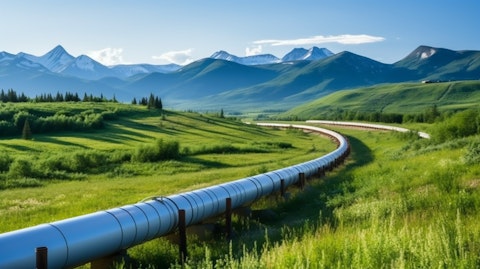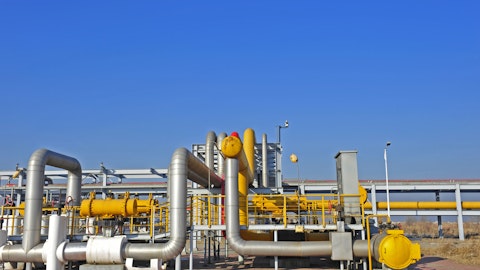Equitrans Midstream Corporation (NYSE:ETRN) Q3 2023 Earnings Call Transcript October 31, 2023
Operator: Hello and thank you for standing by. My name is Regina, and I will be your conference operator today. At this time, I would like to welcome everyone to the Equitrans Midstream Corporation Third Quarter 2023 Earnings Conference Call. All lines have been placed on mute to prevent any background noise. After the speakers’ remarks, there will be a question-and-answer session. [Operator Instructions] I would now like to turn the conference over to Nate Tetlow. Please go ahead.
Nate Tetlow: Good morning. And welcome to the third quarter 2023 earnings call for Equitrans Midstream Corporation. A replay of this call will be available for 14 days beginning this evening. The phone number for the replay is 800-770-2030 or 647-362-9199. The conference ID is 6625542. Today’s call may contain forward-looking statements related to future events and expectations, please refer to today’s news release and risk factors in ETRN’s Form 10-K for the year ended December 31, 2022 and as updated by Form 10-Qs for factors that could cause the actual results to differ materially from these forward-looking statements. Today’s call may contain certain non-GAAP financial measures. Please refer to this morning’s news release and our investor presentation for important disclosures regarding such measures, including reconciliations to the most comparable GAAP financial measure.
On the call today are Tom Karam, Chairman and CEO; Diana Charletta, President and Chief Operating Officer; Kirk Oliver, Senior Vice President and Chief Financial Officer; Justin Macken, Senior Vice President, Gas Systems Planning and Engineering; Janice Brenner, Vice President and Treasurer; and Brian Pietrandrea, Chief Accounting Officer. After the prepared remarks, we will open the call to questions. With that, I will turn it over to Tom.
Tom Karam: Thanks, Nate, and good morning, everyone. Today, we reported third quarter 2023 results, including net income of $130 million, adjusted EBITDA of $250 million and deferred revenue of $83 million. Kirk will provide details on the financial results in a few minutes. Let me start with MVP, about two weeks ago, we revised our targeted completion to the first quarter of 2024 at a total project cost of approximately $7.2 billion, inclusive of $120 million contingency. The revision was driven by multiple factors, including the unexpected difficulty in ramping up construction crews, particularly as a result of the history of court-related construction stops including the nearly three-week court stay in July. Additionally, it was more challenging than expected to source crews with the necessary experience, which was a critical factor given our commitment to the unprecedented level of environmental protocols and safety measures being utilized.
While it took longer than originally planned, by mid-October we were able to reach about 4,500 people working on the right of way, which represents the full complement of workers and we are making good progress every day. Over the next eight weeks to nine weeks, we expect to complete the major boring activities and nearly all waterbody crossings. Closer to year-end, we anticipate the headcount to be reduced to about 1,500 as crews finish up and are released. We are confident in the plan and schedule, and optimistic that MVP can still provide consumers some much needed financial relief this winter. And now, I will turn it to Diana for the operations update and then Kirk will discuss the financial results and I will conclude with some closing comments.
Diana?
Diana Charletta: Thanks, Tom. Good morning, everyone. In the third quarter, we gathered about 8 Bcf per day, representing 8% sequential quarter growth and 6% year-over-year growth. This quarter is a good demonstration of the capability of our system to quickly handle significant production increases. To give you some context, since late Q2, we had a customer turn in line three large pads, each pad producing at an initial flow rate above 200 million cubic feet per day and also added a producer that previously had no volumes on our system and had an average of over 100 million cubic feet per day in Q3. Operationally, we have our backbone gathering and Transmission systems in place and these assets will provide direct upstream connectivity to MVP.
Given this dynamic, combined with the growing demand in the Southeast, the ability to expand MVP capacity by 500 million cubic feet per day through compression and expected improvements to TETCO M2 pricing with MVP in service, we anticipate annual gathering volume growth in the mid-single digits for the years following MVP in service. On the Transmission segment, we commenced construction of the Ohio Valley Connector Expansion Project or OVCX in the third quarter. OVCX is $160 million capital project that will add about 350 million cubic feet per day of incremental capacity. The incremental capacity is targeted for in-service in the first half of 2024. Once the expansion is complete, our OVC pipeline will have the ability to move over 1.2 Bcf a day of gas to Clarington and can also provide backhaul capacity to reach MVP with the same 1.2 Bcf per day of capacity, enhancing basin liquidity and providing customers significant optionality.

On the Water segment, we have completed the trunk line connecting our two above-ground storage facilities, which completes the majority of the backbone of our mixed-use water system. The system now allows for the delivery of over 140,000 barrels per day of mixed water to connected well pads and the ability to receive up to 750 trucks per day for offloading produced water into the system. Moving on to an update on the Rager Mountain Storage well incident that occurred in the fourth quarter last year. In August, we submitted the comprehensive root cause analysis to PHMSA and in October PHMSA approved our injection plan and we began injections at the regular storage field. In the third quarter, we incurred approximately $2.3 million of operating expense related to post-incident activities and for the full year we expect to incur approximately $10 million of expense and approximately $5 million to $10 million of capital related to the Rager incident.
Lastly, on ESG, we are making meaningful progress on incorporating an enterprise data collection framework, which will help standardize processes and improve the efficiency of data collection and reporting requirements. I will now turn the call over to Kirk.
Kirk Oliver: Thanks, Diana, and good morning, everyone. Today, we reported third quarter net income attributable to E-Train common shareholders of $113 million and earnings per diluted common share of $0.26. Net income was $130 million, adjusted EBITDA was $250 million and deferred revenue was $83 million. We also reported net cash provided by operating activities of $202 million and free cash flow of negative $133 million. Net income attributable to E-Train common shareholders was impacted by several items. First, by a $7.8 million write-down of a contract asset in the Water segment. Second, a $3.4 million unrealized loss on derivative instruments, which is reported within other income. This relates to the contractual provision entitling E-Train to receive cash payments from EQT conditioned on specific NYMEX, Henry Hub natural gas prices exceeding certain thresholds post MVP’s in service and through 2024.
And last, by the previously mentioned $2.3 million of operating expense related to the Rager Mountain Storage incident. After adjusting for these items, third quarter adjusted net income attributable to E-Train common shareholders was $123 million and adjusted earnings per diluted E-Train common share was $0.28. Additionally, we reported third quarter equity income of $73.8 million, which is primarily associated with AFUDC relating to MVP construction. Operating revenue for the third quarter of 2023 was $6.8 million higher compared to the same quarter of last year. The increase was primarily driven by increased Transmission usage volumes and higher water volumes and was partially offset by lower gathering revenue. Operating expenses for the third quarter of 2023 were $30.8 million higher than third quarter 2022.
The increase was primarily driven by the $7.8 million write-down of a contract asset in the Water segment; $7.5 million expense related to one-time cash bonus awarded to Tom for his efforts in the inclusion of MVP provisions in the Fiscal Responsibility Act of 2023; $4.5 million of favorable net gas sales, which occurred in the third quarter of 2022; $2.3 million of expenses associated with the Rager Mountain storage field incident; and increased other operating and maintenance, selling, general and administrative expenses. In October, we entered into an amendment to the EQM credit facility, extending the maturity by one year to April of 2026. As of today, the revolver size is $1.55 billion and reduced to $1.45 billion in April of 2025. For the third quarter, E-Train will pay a quarterly cash dividend of $0.15 per common share on November 14th to shareholders of record at the close of business on November 3rd.
And last, we updated our 2023 guidance to reflect revised MVP timing and project cost estimates. The full year guidance is available in today’s third quarter earnings release. I will now hand the call back to Tom.
Tom Karam: Thanks, Kirk. As you know, Diana will be taking over as CEO on January 1st and I will be moving to the Executive Chair role, so this will mark my final earnings call. Diana is respected by our colleagues and across the midstream industry. She displays an unrelenting work ethic and has undoubtedly earned this role. Looking back on the last five years, I can say with near certainty that no company, management team or Board of Directors has handled adversity, as well as this group. I am honored to be associated with all of them. When you focus on our core business, you see an integrated system that gathered and safely moved 8 Bcf per day in Q3 or about 8% of the total daily production in the United States. This really didn’t happen by accident, it took an amazing team effort to construct, integrate and operate the assets, while at the same time maintaining much needed financial flexibility and all of this done with safety and environmental stewardship as top priorities.
So in closing, it’s been an eventful last five years, filled with many successes and challenges, and I could not have had a better team or Board by my side. I look forward to serving as Executive Chair and to the future success under Diana’s leadership. With that, we are happy to take your questions.
See also 10 Stocks Receiving a Massive Vote of Approval From Wall Street Analysts and 11 Best Retail Stocks To Buy Now.
Q&A Session
Follow Equitrans Midstream Corp
Follow Equitrans Midstream Corp
Operator: [Operator Instructions] Our first question will come from the line of Spiro Dounis with Citigroup. Please go ahead.
Unidentified Analyst: Hi. This is Chad [ph] on for Spiro. I guess just starting off, just wanted to talk about the risking of the latest MVP timeline and security there, I believe you mentioned that the construction crews are sufficient now to hit that 1Q 2024 target. But just wanted to see if there’s any underlying assumptions that need to change in order for that timeline to be achievable or are you kind of status quo continues, you should be able to hit 1Q 2024? Thank you.
Diana Charletta: Yeah. So we should be able to hit 1Q 2024. We are making steady progress right now. Last week we passed over the halfway point for a number of water crossings. The weather has been cooperative. So our current schedule was developed considering the full complement of crews based on their productivity over the last 60 days or so and certainly considering the heightened environmental protocols that we have been talking about. The labor issue is behind us. We are prioritizing more of that difficult work first, while we have more daylight and more favorable weather. We expect to have the majority of construction complete by year-end. We will still have a handful of crossings to complete and we maybe finishing up some bores, but and maybe some upland work, but largely January we will be commissioning.
Unidentified Analyst: Okay. That’s helpful. And I guess just following up, I know that you have mentioned the MVP — a potential MVP expansion in the opening remarks. I guess just thinking about it once the mainline comes online, how quickly could that opportunity emerge and how — any kind of details that you can give there on time?
Diana Charletta: So it is a small and more compact project in the mainline, it’s more simplistic when it comes to regulatory and permits that we need. We need about 12 months after we get an open season, everybody ready for the regulatory process and then about 12 months for construction and we should — we are working — we have seen a lot of demand from both producer and demand-pull customers for that expansion and we will go out — you will see us go out for an open season when we feel like the time is right, but we are — customers are asking.
Unidentified Analyst: Okay. Okay. Understood. Makes sense. Thanks for the time today.
Diana Charletta: Thank you.
Operator: Your next question comes from the line of Burke Sansiviero with Wolfe Research. Please go ahead.
Burke Sansiviero: Hi. Good morning and thank you for taking my questions.
Tom Karam: Hi.
Burke Sansiviero: On the listed factors for the MVP cost increase, would you be able to identify any in particular as the largest workforce issues or items from the PHMSA agreement or any other?
Diana Charletta: So it wasn’t items from the PHMSA agreement. We were largely aligned and had largely planned to do the things that were outlined in the order before the agreement was done. I would say, more than half of the increase was linked to the slow ramp in crews that we didn’t foresee and the challenges to construction in part due to the heightened environmental protocols, that’s the largest.
Burke Sansiviero: Thank you. And is the anticipated mid-single-digit growth specific to just the gathering system or across all the assets and also the 350 million cubic feet step up and the firm capacity gathering volumes, was that from any new MVCs that were signed?
Diana Charletta: That 350 million cubic feet, is that?
Tom Karam: MVC.
Diana Charletta: Yeah.
Tom Karam: Yeah. I think there was — I think largely associated with the new customer on the gathering.
Diana Charletta: Oh! Oh! Oh!
Tom Karam: And your first question on the mid-single-digit growth. I mean, yes, that would be on the gathering systems. We do have a pretty integrated system with the Transmission, so we would expect to see related growth on the Transmission system, as well as those gathered volumes, some of them move on the Transmission as well, but that mid-single-digit was related to gathering — gathered volume growth.
Burke Sansiviero: All right. Thank you. I appreciate the time.
Operator: Your next question comes from the line of John Mackay with Goldman Sachs. Please go ahead.


